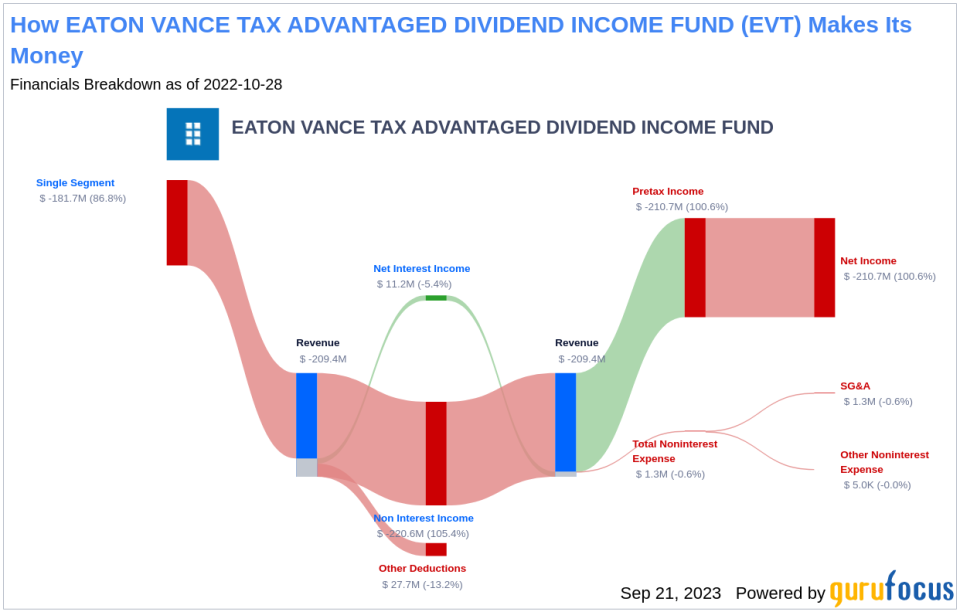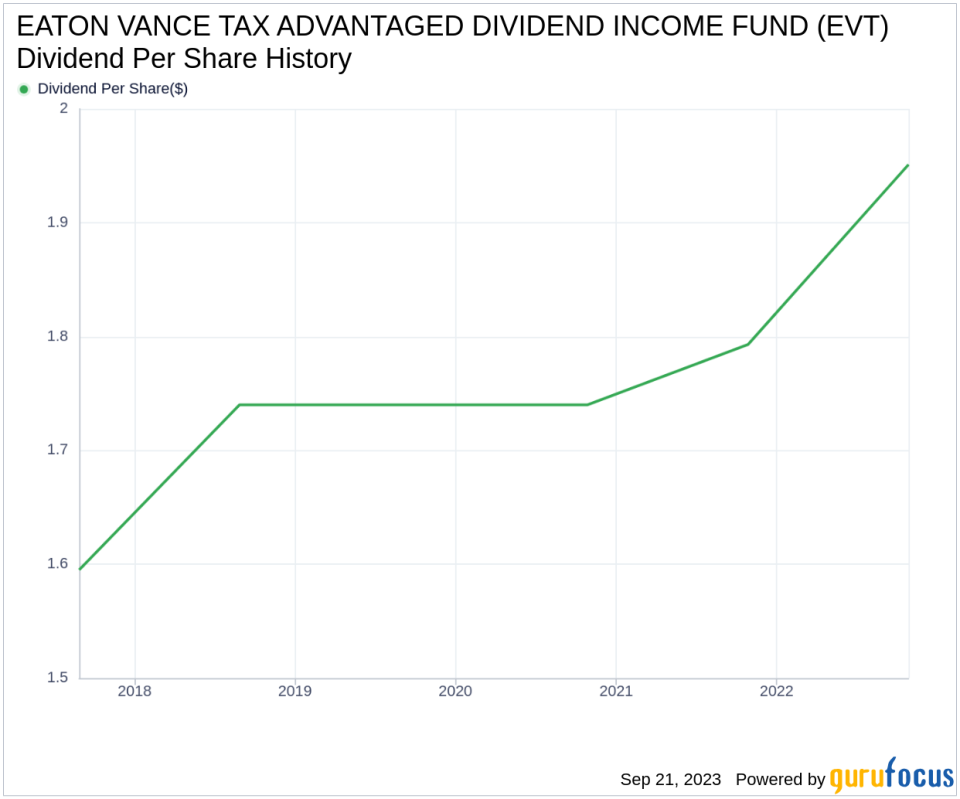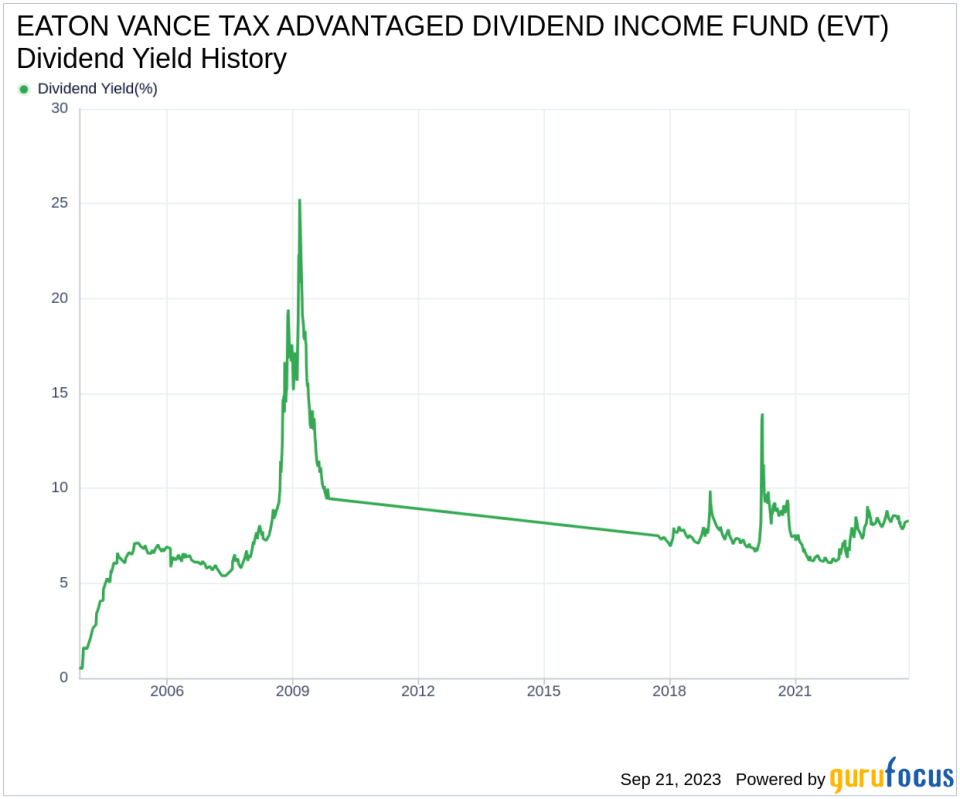Unveiling the Dividend Performance of EATON VANCE TAX ADVANTAGED DIVIDEND INCOME FUND (EVT)
A comprehensive analysis of EVT's dividend history, yield, growth, and sustainability
EATON VANCE TAX ADVANTAGED DIVIDEND INCOME FUND (NYSE:EVT) recently announced a dividend of $0.15 per share, payable on 2023-09-29, with the ex-dividend date set for 2023-09-21. As investors look forward to this upcoming payment, the spotlight also shines on the company's dividend history, yield, and growth rates. Using the data from GuruFocus, let's deep dive into EVT's dividend performance and assess its sustainability.
Understanding EATON VANCE TAX ADVANTAGED DIVIDEND INCOME FUND
Warning! GuruFocus has detected 6 Warning Signs with JTCPF. Click here to check it out.
This Powerful Chart Made Peter Lynch 29% A Year For 13 Years
How to calculate the intrinsic value of a stock?
EATON VANCE TAX ADVANTAGED DIVIDEND INCOME FUND is a diversified, closed-end management investment company. Its objective is to provide a high level of after-tax total return consisting mainly of tax-advantaged dividend income and capital appreciation. The fund pursues its objective by investing primarily in dividend-paying common and preferred stocks. Its portfolio of investments consists of electric utilities, energy equipment and services, food products, health care providers and services, internet software and services, and other areas.
Reviewing EVT's Dividend History
EATON VANCE TAX ADVANTAGED DIVIDEND INCOME FUND has maintained a consistent dividend payment record since 2003. Dividends are currently distributed on a monthly basis. Below is a chart showing annual Dividends Per Share for tracking historical trends.
Dissecting EVT's Dividend Yield and Growth
As of today, EVT currently has a 12-month trailing dividend yield of 8.28% and a 12-month forward dividend yield of 8.15%. This suggests an expectation of decrease dividend payments over the next 12 months.
Over the past three years, EVT's annual dividend growth rate was 3.90%. Extended to a five-year horizon, this rate decreased to 3.20% per year. Based on EVT's dividend yield and five-year growth rate, the 5-year yield on cost of EVT stock as of today is approximately 9.69%.
Is EVT's Dividend Sustainable? Evaluating Payout Ratio and Profitability
To assess the sustainability of the dividend, one needs to evaluate the company's payout ratio. The dividend payout ratio provides insights into the portion of earnings the company distributes as dividends. A lower ratio suggests that the company retains a significant part of its earnings, thereby ensuring the availability of funds for future growth and unexpected downturns. As of 2023-04-30, EVT's dividend payout ratio is 0.00.
EVT's profitability rank, offers an understanding of the company's earnings prowess relative to its peers. GuruFocus ranks EVT's profitability 2 out of 10 as of 2023-04-30, suggesting the dividend may not be sustainable. The company has reported net profit in 4 years out of past 10 years.
The Future Outlook: Growth Metrics
To ensure the sustainability of dividends, a company must have robust growth metrics. EVT's growth rank of 2 out of 10 suggests that the company has poor growth prospects and thus, the dividend may not be sustainable.
Conclusion
While EVT has a commendable dividend history, the current indicators raise questions about the sustainability of its dividends. The low profitability rank and growth rank could potentially impact future dividend payments. Therefore, investors should carefully consider these factors while making investment decisions. GuruFocus Premium users can screen for high-dividend yield stocks using the High Dividend Yield Screener.
This article first appeared on GuruFocus.



